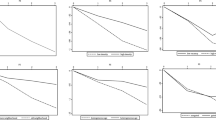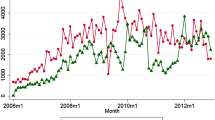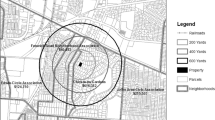Abstract
Neighborhood quality is an important attribute of housing yet its value is rarely known to researchers. We argue that changes in nearby foreclosures reveal changes in neighborhood quality. Thus estimates of the hedonic price of nearby foreclosures provide a glimpse of values that people hold for local neighborhood quality. The empirical models include controls for both spatial dependence in housing prices and in the errors. The estimates indicate that nearby foreclosures produce externalities that are capitalized into home prices—an additional foreclosure within 250 feet of a sale negatively impacts selling price by approximately $1,666, ceteris paribus.
Similar content being viewed by others
Notes
“Affordability” products include subprime loans or mortgages with interest only and payment option features.
According to the literature review in Edelberg (2003), in 1995 bank regulators implemented more stringent measures of Community Reinvestment Act (CRA) compliance that motivated the development of technology to facilitate lending in high-risk neighborhoods. This motivation along with decreasing costs of information storage and computing power resulted in innovations in credit pricing.
Default occurs when a borrower fails to make his/her mortgage payment. Not all defaults result in foreclosure, but all foreclosures necessarily began as a borrower default.
In this static model, the purchase price does not change.
Since N i is considered a good, we assume that ∂A/∂N i > 0.
A small percentage of the sales are in Collin, Denton, Ellis, and Tarrant Counties because the boundaries of some of the cities in Dallas County extend into other counties.
Ambrose and Capone (2000) found elevated risk of another default within 2 years of foreclosure.
The number of observations was 23,960, 27,273, 28,549, and 26,456, respectively.
All of these values are determined with the natural log of price so that they are in the same units as the dependent variable.
In a regression without OWN but with OWNOCC_BG, we found that the addition of OWN′ to the regression caused the effect of OWNOCC_BG to fall by approximately 67%.
The spatial multiplier for a spatial lag model is calculated as (1 − W 06 ρ)−1, but this reduces to (1 − ρ)−1 when the weight matrix is standardized (Kim et al. 2003).
References
Ambrose BW, Capone CA (2000) The hazard rates of first and second defaults. J Real Estate Finance Econ 20(3):275–293
Anselin L (1988) Spatial econometrics: methods and models. Kluwer, Dordrecht
Anselin L, Florax R (1995) New directions in spatial econometrics. Springer, London
Can A (1992) Specification and estimation of hedonic housing price models. Reg Sci Urban Econ 22:453–474
Capone CA (2001) Introduction to the special issue on mortgage modeling. J Real Estate Finance Econ 23(2):131–137
Cotterman RF (2001) Neighborhood effects in mortgage default risk. U.S. Department of Housing and Urban Development, Office of Policy Development and Research. http://www.huduser.org. Accessed 16 Aug 2007
Dubin R (1992) Spatial autocorrelation and neighborhood quality. Reg Sci Urban Econ 22:433–452
Edelberg W (2003) Risk-based pricing of interest rates in household loan markets. Federal Reserve Board Finance and Economics Discussion Series No. 2003-62
Fernald M (2008) The state of the nation’s housing, 2007. Joint Center for Housing Studies, Cambridge
Gaines JP (2007) Preserving homeownership: addressing the foreclosure issue. Presentation given at the Federal Reserve Bank of Dallas Preserving Homeownership conference on 12 June 2007
Immergluck D, Smith G (2005) There goes the neighborhood: the effect of single-family mortgage foreclosures on property values. Woodstock Institute. http://www.woodstockinst.org/component/option.com/. Accessed 6 Sept 2007
Kau JB, Keenan DC (1995) An overview of the option-theoretic pricing of mortgages. J Hous Res 6(2):217–243
Kelejian HH, Prucha IR (1998) A generalized spatial two-stage least squares procedure for estimating a spatial autoregressive model with autoregressive disturbances. J Real Estate Finance Econ 17:99–121
Kelejian HH, Prucha IR (2006) Specification and estimation of spatial autoregressive models with autoregressive and heteroskedastic disturbances. http://www.albany.edu/economics/Research/fall06/1208.pdf. Accessed 2 Jan 2009
Kim CW, Phipps TT, Anselin L (2003) Measuring the benefits of air quality improvement: a spatial hedonic approach. J Environ Econ Manag 45:24–39
Lin Z, Rosenblatt E, Yao VW (2009) Spillover effects of foreclosures on neighborhood property values. J Real Estate Finance Econ 34(4):387–407
Páez A, Long F, Farber S (2008) Moving average approaches for hedonic price estimation. Urban Stud 45(8):1565–1581
Rosen S (1974) Hedonic prices and implicit markets: product differentiation in perfect competition. J Political Econ 72:34–55
United States Foreclosure Law (2007) Texas foreclosure law summary. http://www.foreclosurelaw.org/Texas_Foreclosure_Law.htm. Accessed 20 Oct 2007
US Census Bureau (2007) Housing vacancy survey. http://www.census.gov/hhes/www/housing/hvs/hvs.html. Accessed 2 Aug 2007
Acknowledgments
We wish to thank Nathan Berg, Magnus Lofstrom and two anonymous reviewers for helpful comments.
Author information
Authors and Affiliations
Corresponding author
Rights and permissions
About this article
Cite this article
Leonard, T., Murdoch, J.C. The neighborhood effects of foreclosure. J Geogr Syst 11, 317–332 (2009). https://doi.org/10.1007/s10109-009-0088-6
Received:
Accepted:
Published:
Issue Date:
DOI: https://doi.org/10.1007/s10109-009-0088-6




